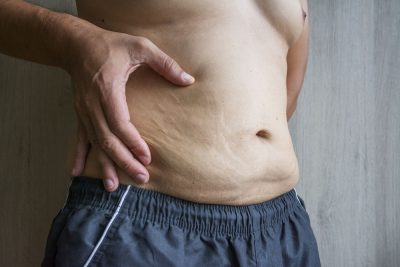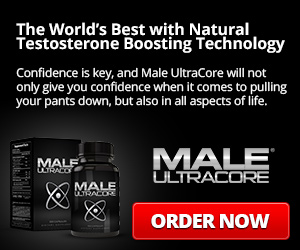Stretch mark is a type of skin scarring that occurs when the skin expands or shrinks too fast. When this happens, it causes damage to the collagen and elastin – skin components. However, this isn’t permanent damage, as it can be repaired.
Although the skin is considered flexible, it can get to a point where it is unable to stretch without causing tears and scarring, which is referred to as stretch marks.
Stretch marks appear on the skin due to how the skin fixes itself. However, some treatments can be used to treat and reduce the appearance of stretch marks.
Stretch marks first occur in the dermis – the middle layer of the skin, responsible for keeping the skin’s shape intact. This stretch further leads to the breaking of blood vessels in the skin, and it results in the pinkish or purplish color of stretch marks.
With time, the skin’s normal pigmentation can return to normal, but the tissues would most likely remain shiny.
In most people, stretch marks happen in two phases. Firstly, it may appear as red/purple jagged lines on the parts of the skin that has stretched, and it can become itchy as well. Along the line, the stretch mark lines begin to disappear and fade.
At this stage, the stretch marks become colorless and have less weight than the skin surrounding it, and that’s because the pale fat underneath the skin becomes more evident than the blood vessels.
For men, stretch marks can appear anywhere; it can be on the calves, thighs, and buttocks, but frequently it appears on the buttocks for adult males.
While stretch marks aren’t considered harmful, they can look unpleasant on the skin, which can lead to emotional distress. Tanning of the skin won’t precisely diminish the appearance of stretch marks on your skin; instead, it makes it more visible.
Medically the term “stretch mark” is referred to as “striae distensae,” and it can be a source of irritation. Stretch marks are natural occurrences to the human body, and they can happen to anyone, men inclusive.
There are many rumors about stretch marks occurring in just women due to pregnancy – when their skin stretches to accommodate a baby.
These myths and rumors are very untrue because men can have stretch marks too, and certain factors increase their risks of getting these marks.
Causes of Stretch Marks in Men
Research has still been unable to figure out a particular cause for stretch marks in men, but they have pointed out a combination of factors that can result in changes in the skin.
The causes of stretch marks in men are not all that different from women. These include:
Rapid puberty growth
This causes stretch marks to appear on the upper arms, thighs, buttocks, and the back.
 Bodybuilding
Bodybuilding
Bodybuilding causes muscles to overgrow, and this rapid growth triggers the formation of stretch marks along with the muscles’ surroundings. The areas include the outer edge of the chest or the shoulder muscles.
Hormones
Doctors believe that stretch marks can be caused by life events like puberty and drastic weight gain, and these factors can be influenced by hormones, leading to the stretching of the skin.
Stretch marks can also be genetic; if any of your family members have it, you are more likely to develop these marks later in the future.
Rapid weight gain
Obesity, which is the accumulation of excess fat, can lead to the stretch marks on the abdomen and other parts of the body. Gaining weight from too much eating can overstretch your skin past its elasticity, and result in stretch marks.
Using corticosteroids creams/drugs
Extended use of corticosteroids to maybe treat eczema can cause your skin to develop stretch marks. Crams such as prescription-strength hydrocortisone can cause these marks to appear on the skin, as it can cause thinning of the skin.
Corticosteroid drugs used for treating inflammation and autoimmune disorders can make your skin more prone to stretch marks. Using anabolic steroids by some bodybuilders may also contribute to the appearance of stretch marks on the skin.
Aside from these factors, some men are more susceptible to stretch marks than others. This is mostly true in men who have certain health conditions that can lead to the excess production of hormones like “corticosteroids.”
Corticosteroid is a hormone responsible for the production of skin cells identified as “fibroblasts present” in the dermis and “keratinocytes” in the epidermis.
Fibroblasts are essential, as it is responsible for the production of collagen that keeps the skin flexible. When there is surplus production of corticosteroids, it reduces collagen production, making the body inflexible.
Various health conditions result in the overproduction of corticosteroids; these include:
- Marfan syndrome: This condition can cause a decrease in skin tissue elasticity, making it prone to stretch marks.
- Cushing’s syndrome: This health condition can lead the body to excess hormones that stimulate rapid weight gain and result in skin fragility. When the skin becomes fragile, it loses its elasticity, making it unable to stretch.
- Ehlers-Danlos syndrome
Risk Factors Associated with Stretch Marks in Men
Several factors can contribute to why some men are more prone to stretch marks than others. However, these factors don’t precisely have thorough facts backing them up, and more research would be needed.
However, the risk factors could be linked to:
- Chronic health conditions
- Family history/Genetics
Diagnosis
Stretch marks are diagnosed quickly based on your personal history and family medical history, and also skin examination.
Your doctor may ask you questions concerning the signs and symptoms you have been experiencing, and also questions on what medications are being used or previously used. You might also need to communicate on previous or existing health conditions.
Stretch marks don’t pose any threat to your health, but in some rare cases, it may indicate an underlying health condition that needs to be monitored or treated.
Treatment
 Treating stretch marks to fade it off completely can be expensive, and sometimes not effective. Unless an underlying health condition causes it, your health insurance may not fund it, as it is considered a cosmetic complaint.
Treating stretch marks to fade it off completely can be expensive, and sometimes not effective. Unless an underlying health condition causes it, your health insurance may not fund it, as it is considered a cosmetic complaint.
There are many creams and lotions in the market that are being proposed as treatments to fade stretch marks away without any side effects, but they do not have any concrete backing. There is little or no medical evidence supporting these claims.
There is no scientific evidence stating the effectiveness of lotions, creams, or oils on stretch marks to reduce the appearance.
Topical treatments are substances that contain active ingredients that can be applied on the skin, and these treatments can have little effects on the fading of stretch marks.
Most times, stretch marks fade away after a long while and become less noticeable or unnoticeable. You can also use makeup to conceal stretch marks on your body’s exposed parts if you don’t feel comfortable.
Still, some natural products are being said to have positive results in getting rid of stretch marks. They include:
- Cocoa butter
- Vitamin E
- Almond oil
- Olive oil
Remember that there is no scientific backing to these treatments, but you can use them when you notice the first sign of stretch marks, which is itching. That’s because some of these products don’t have any effect on old stretch marks.
Massaging the products into your skin might help it work better, as massaging seems to improve a product’s effectiveness. Make sure to apply these products consistently for several weeks until you notice a change.
But if after prolonged use, and you don’t see any significant change, you can still keep using because these products are considered natural moisturizers.
Creams and lotions might not help you fade away the appearance of stretch marks on your skin, but it can help provide relief from the itching. Plus, you can also cover up the stretch marks with self-tanner but don’t tan your skin, as it can make stretch marks more visible.
Some medical treatments can help to reduce the appearance of stretch marks; these include:
- Laser therapy
- Radiofrequency
- Chemical peel
Prevention
As there are no defined causes for stretch marks, it can be challenging to prevent it. However, you can take the following measures to reduce your risk of developing stretch marks.
- Eat a balanced diet containing proper vitamins and minerals. Consumption of foods rich in vitamins A and C can help support the flexibility of the skin, the same with zinc and silicon. However, if you feel that you aren’t getting enough of these vitamins from your diet, you can opt for supplements rich in these vitamins.
- Try as much as you can to maintain a healthy weight. That’s because being obese is a significant factor in developing stretch marks on your skin.
- Stay properly hydrated. Drink about eight glasses of water daily to keep your skin firm and supple.
- Do not involve yourself in drastic measures that would make you lose weight rapidly.
- Avoid engaging in yo-yo dieting.








COMMENTS